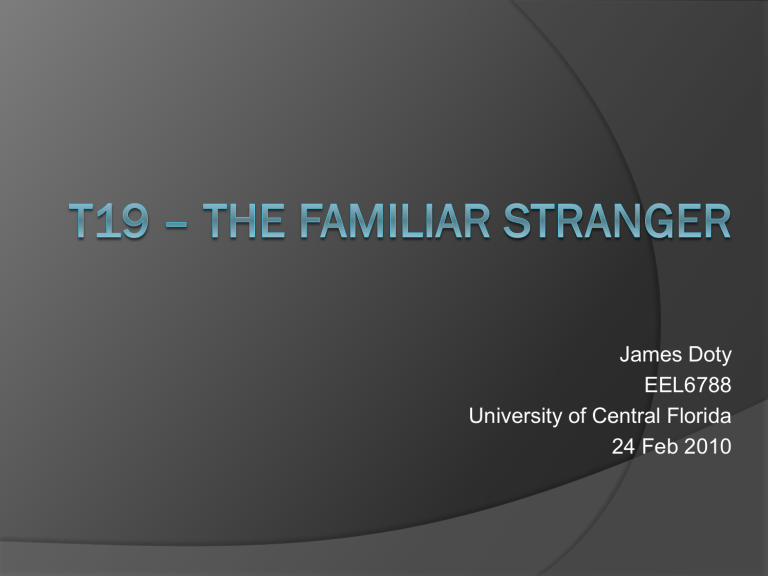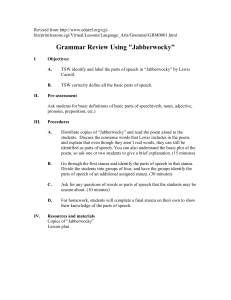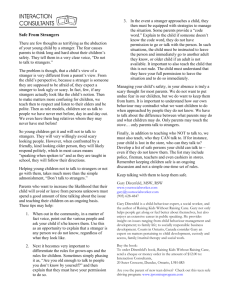James Doty EEL6788 University of Central Florida 24 Feb 2010

James Doty
EEL6788
University of Central Florida
24 Feb 2010
Introduction
Do you see the same people, day after day, but you never say hello?
Have you ever concocted a story or name for someone you see regularly?
What makes you comfortable in a new situation?
About Me
BS Computer Engineering
Purdue University, May 2006
Software Engineer
Harris Corporation, Palm Bay, FL
MS Computer Engineering student
University of Central Florida
About the Authors: Eric Paulos
Currently a Professor at Carnegie Mellon
University
Human-Computer Interaction
Secondary appt. with Robotics Institute
Adjunct faculty with Entertainment Technology
Center
PhD. In Electrical Engineering from UC
Berkeley
Developed some of the first internet teleoperated robots
Formerly a Senior Research Scientist at
Intel Research in Berkeley, CA
About the Authors: Elizabeth Goodman
Most recently, a visiting researcher at
Microsoft Research
She has written articles for magazines such as Wired, Forbes, and Salon
Interests are varied and include urban green space design, personal media, health technology, and other urban technology studies
Former Professor at UC Berkeley
School of Information
Intel Research Berkeley
Urban Atmospheres
“… the very essence of person, place, and community are being redefined by personal wireless digital tools that transcend traditional physical constraints of time and space.”
Other projects include mobile environmental research, place-based personal ringtones, and quantifying your relationship with a city (among other things)
Familiar Strangers
People seen regularly in a location but never spoken to
They often shape our view of a place
They play a key role in our day-to-day social interactions
Formal definition:
Must be observed repeatedly
Must have no real interaction
Scenario 1
“A woman who has recently graduated from college has moved to a new city and doesn’t feel at home. The display on her familiarity device reinforces her growing sense of integration within her new neighborhood, and reassures her that familiar people are nearby, even if she does not recognize their faces. When she explores unfamiliar neighborhoods in the larger city, she is occasionally surprised to discover how many people around her she has encountered before.”
Scenario 2
“In the midst of a frustrating day, an urban professional decides that he doesn’t want to eat lunch in his usual spot. After years at the same job, the large city seems more like a small town.
He sees the same people every day in the same places. He wants to escape. As he walks quickly away from his work, he occasionally checks his familiarity device to see if there are any Familiar
Strangers nearby. When he finds a street that the device tells him is completely unfamiliar, he chooses a restaurant. He feels as if he’s exploring new territory and though he is still surrounded by other people, he feels much less crowded than he did 15 minutes ago.”
History
First identified by Stanley Milgram in 1972
Stanley took photos of a subway platform during rush hour, then exactly one week later passed them out asking people who they recognized
Milgram identified that 89% of those surveyed recognized at least one person in the photo
Other Findings
Milgram also recognized that some people are more recognizable than others
Unusual features help someone stand out –
Milgram’s example was a girl wearing a short skirt regularly in winter
Intel Research Goals
To establish a baseline for the current state of our relationship with Familiar Strangers
Expose changes to the Familiar Stranger relationship in the past 30 years
Authors theorize that people in constant contact with cell phones (and paying more attention to technology than surroundings) leads to a reduction in familiar strangers
Discover how familiarity affects perception of place
Procedure 1 – Milgram Revisited
Like Milgram’s subway photos, the authors took a photo of a public square in Berkeley, CA both at rush hour and at lunch
They were targeting commuters at the bus transfer station at rush hour and office workers eating lunch in the park
They returned a week later and surveyed the population about who was recognized
Results 1
Although they found less stranger familiarity than Milgram, they did find a strong recognition rate
Percent recognizing at least one person
Average recognized
Milgram
89%
4.0
Intel
77.8%
3.1
3.9 at lunch
2.3 at rush hour
33/63 were recognized by at least one person
Procedure 2 – Urban Walking Tour
They took 9 Bay Area residents on a walking tour through Berkeley’s
Each tour was 45 minutes long and visited four distinct locations, with participants free to suggest other locations
Constitution Plaza – from study #1
Berkeley Post Office
Civic Center Park
A common inexpensive restaurant
Procedure 2
Tour guides were asked to rate their comfort from 1-5 and to rank their reasons:
People around you
Physical characteristics (of location)
Environmental attributes (weather, time)
They were measuring four quantifiable factors:
Amount – how many familiar people
History – how familiar are people
Turf
– “my kind of place”
Tribe – “my kind of people”
People were also re-evaluated with a simulated “familiar stranger detector” device
Procedure 2 Results
Comfort levels varied, more so for women than men
Participants were most comfortable at the Post Office, least at the park
“People around me” was the most common factor, both positive and negative
Information from the fictitious device was valuable in all cases, especially at the park and restaurant
Where does this lead?
Jabberwocky – the familiar stranger device
Jabberwocky was guided by previous formal studies and anecdotal observations
It captures and extends the essence of the Familiar Stranger relationship
Jabberwocky Concept
Small digital tags
Tags can be either worn by people or fixed to a location such as a bus stop
Digital Scents
An individual carrying a Bluetooth phone is the modern equivalent of a unique
“scent”
Fixed locations can leave “scents” as well by affixing a tag
As two individuals approach, each person’s Jabberwocky detects and records the other’s unique scent
Jabberwockys also record fixed locations by digital tags
Familiar Strangers
The number of familiar strangers nearby is an intersection of the set of frequently recorded scents and the current scents nearby
This can also tell how familiar a person or crowd is based on frequency and duration of previous contacts
Turf
Turf is marked by fixed tags
Fixed tags emit a signal to differentiate themselves from mobile tags
They record and communicate all of the strangers that pass by
The intersection of your previous contacts and the device’s contacts is how much this is “your turf”
HW Design
Prototypes used Motes
Small, low power, embedded processors with built in wireless connectivity including Bluetooth
One benefit is that each Jabberwocky tag owns its own data
The lack of a centralized server helps lessen some (but not all) privacy concerns
Interface
Major challenges
Representing and interacting with complex social data
It was important to avoid the feel of a personal tracking device by dealing more with groups, not individuals
Two interfaces
Mote
Cell phone
Mote Interface
Red
Flashing – the number of familiar strangers who have also been here
Solid – the number here now
Green and blue
Allow a user to group familiar strangers into two categories (i.e. work and home)
Cell Phone Interface
Cell Phone Interface
Strangers appear at the top of the screen and slowly drift downward
They disappear after about 10 minutes
Cell Phone Interface
No Mote required
Uses the industry standard MIDP 2.0 and was written using Java Micro
Edition (J2ME)
Testing was done on a Nokia 6600, but any J2ME handset with Bluetooth should work
Unfortunately, this will not run on the iPhone
Closing Remarks
The authors specifically mention that these devices aren’t intended to make familiar strangers friendlier
They act as a necessary buffer between known people and complete strangers
The devices act merely to help identify and recognize the familiar stranger relationship and it’s relation to one’s environment
Further Research
This paper is cited by numerous other urban sociology papers
The focus is more on the follow-up to the Millgram study
The technical aspects and social implications of
Jabberwocky are almost always ignored
Although the Jabberwocky cell phone app is available for download, the source is not
Runs on outdated technology – J2ME
Because the paper authors no longer work for Intel, any further development or commercialization of
Jabberwocky is unlikely at this time
Even the Intel Research website is out of date
My Thoughts
I had never considered the concept of Familiar
Strangers before
I’m going to start paying more attention
I can relate to socio-metric stars
Coming from a suburban/rural environment, I cannot relate as well as someone who lived in an urban environment like Berkeley or Manhattan
Jabberwocky seems useful if exploring a new part of a known city, but useless (initially) in a new city
Personally, I’m a bit uncomfortable with a device recording my movements, even if the average user does not have access to my individual data
Sources
Paulos, Eric http://www.paulos.net/bio.html
Goodman, Elizabeth http://www.confectious.net/
Jabberwocky, Intel Research http://www.urbanatmospheres.net/Jabberwocky/info.htm
Milgram, Stanley “T he individual in a social world : essays and experiments.”
Addison-Wesley Pub. Co., 1977



